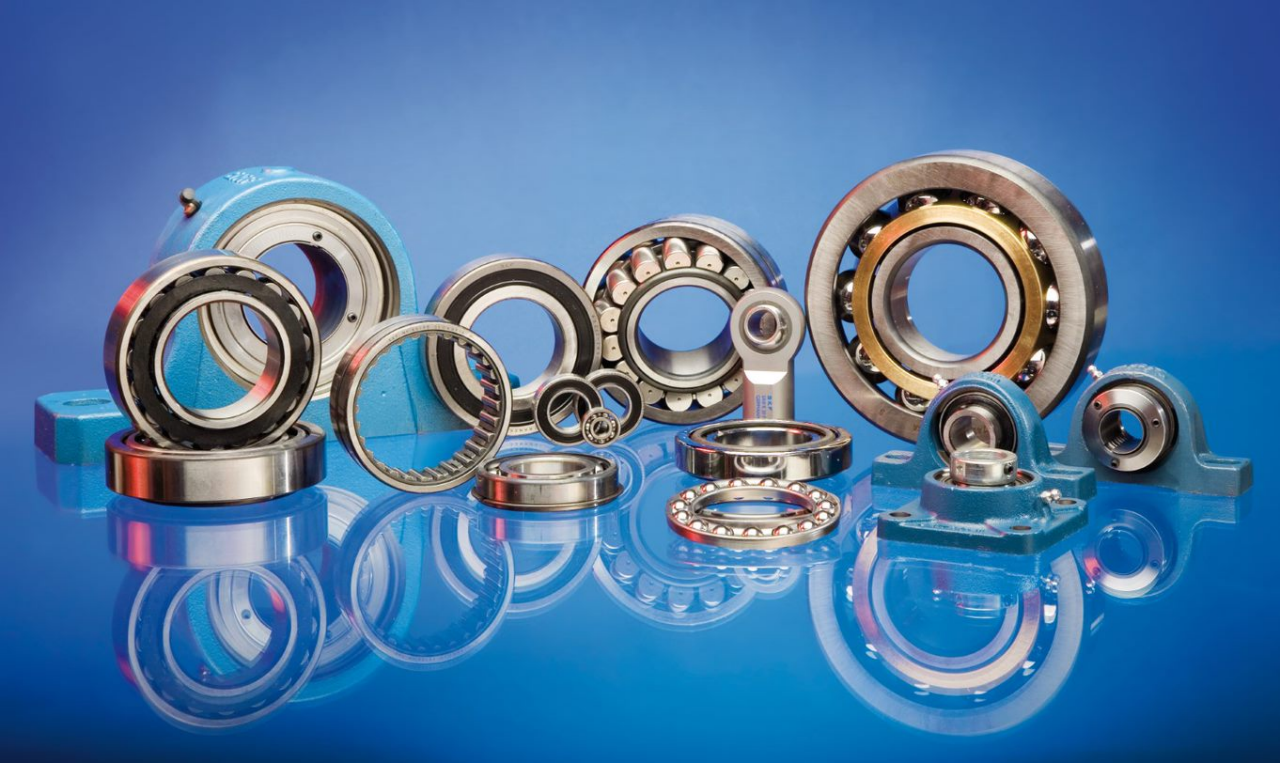In this article
Bearing grease: select the right lubrication method in 5 steps
Bearing grease prevents the metal parts of bearings from coming in contact with each other. Therefore, it is essential for the good function and service life of the bearings. You need to re-grease the bearings after most applications. The old lubricant may still be in place, but it eventually dries up and this makes the lubricant less effective. So, get greasing!
Identify the type of bearing:
First, determine what sort of bearing you have, and then you can choose the type of grease. Do you have a plain bearing or a bearing with rolling elements (balls, rollers etc.)? A plain bearing has a PTFE coating, and you don't need to re-grease it. However, a roller bearing needs to be lubricated with grease or oil.
Which lubricant is right for which bearing? Check these 5 steps:
- Determine the type of bearing grease
- Check the basic requirements of the lubricant
- Determine the required viscosity index value of the base oil in the bearing grease
- Select the type
- Choose the right lubricant
Step 1: Determine the type of bearing grease
Generally speaking, there are 3 types of lubricant used for bearings:
- PTFE coating
- Lubricant with grease: which grease for which bearings?
- Lubricant with oil: which oil for which bearings?
PTFE coating
This only applies to plain bearings. The manufacturer applies this lubricant. Coated bearings are available - you don't need to re-grease them and they usually need very little maintenance.
Lubricants with grease: which grease for which bearing?
This type of lubricant is suitable for sealed and open bearings. Sealed bearings, such as 2RS and ZZ, are pre-filled with grease. In principle, you won't need to re-grease them, except for bearing units. You can grease these often because the units are usually used in exceptional operating conditions, such as extremely high or low temperatures and a humid or highly polluted environment. You need to re-grease open bearings regularly. Open bearings are delivered from the factory without a grease filling and should be filled with the selected or recommended lubricant before installation.
Lubricants with oil: which oil for which bearing?
Oil is often used for gear boxes and gear units. We also see it used for bearing housings in extreme conditions such as high rotational speeds and high temperatures. Oil is the ideal sort of lubricant for these kind of situations.
Step 2: Check the basic requirements of the lubricant
Lubricants consist of three substances. These substances are combined in the form of an effective, semi-fluid grease that is suitable for specific applications.
- Base oil (70-90%) - for effective lubrication
- Thickening agent (5-30%) - for long-term effectiveness
- Additives (1-5%) – for specific characteristics
Requirements for an effective lubricant
No matter what branch you work in, these requirements apply to every type of lubricant:
- Good oil lifetime - this saves on maintenance
- Reliable protection against wear and corrosion
- Promotes system efficiency
Step 3: Determine the required viscosity index value of the base oil in the bearing grease
The viscosity index value of the base oil in the bearing grease indicates how well the oil will function at certain temperatures, speed and load conditions. The higher the value, the thicker the grease. The lower the value, the thinner the grease. Choosing the wrong viscosity index value may lead to friction and/or overheating of the bearing.
How do I choose the right viscosity index value?
At a higher temperature, the viscosity index value must be higher than at a lower temperature
At a higher load rating, the viscosity index value must be higher than at a lower load rating
At a higher rotation speed, the viscosity index value must be lower than at a lower rotation speed
At a high speed and low temperature, the viscosity index value must be low
At a high load rating and high temperature, the viscosity index value must be high
Step 4: Select the type
Lubricants are normally based on a mineral oil and a chemical thickening agent. The later is often described as the ‘soap skeleton’. Various compositions make the type of lubricant suitable for certain operating conditions, including high or low temperatures, rotational speed and load. Lubricants for bearings can be sub-divided into several types:
Lithium grease |
Sodium grease
Calcium grease
Mixed grease
|
Mineral oil base
(Polyatomic) ester oil base) |
Silicone oil base |
Dropping point (⁰C) |
170-195 |
170-195 |
200-21 |
170-210 |
70-90 |
160-190 |
Suitable for temperatures (⁰C) between:
-20 and 110 |
-50 and 130 |
-50 and 160 |
-20 |
-20 |
-20 |
Rated speed (percentage of permitted rotational speed of bearing)
70
100
60
70
40
70
Mechanical stability
Good |
Good
Good
Good |
Poor
Good |
Pressure Resistance
Satis
factory
Satis
factory
Poor
Satis
factory
Poor
Variable
Water Resistance
Good
Good
Good
Very Poor
Good
Poor in the case of Natrium mix
Complex grease
|
Soap-free grease
Mineral oil base |
Synthetic oil base
Dropping point (⁰C) |
180-300 |
more than 230
more than 230
Suitable for temperatures (⁰C) between:
-20 and 130
-10 and 130 |
Below 220
Rated speed (percentage of permitted rotational speed of bearing) |
70
70
40-100
Mechanical stability |
Good |
Good
Good
Pressure Resistance |
Variable
Poor
Poor |
Water Resistance
Good
Good
Good
Step 5: Choose the right lubricant
The table below contains a useful overview. You can see immediately which SKF lubricant is suitable for various operating conditions.
At medium rotational speeds (up to 300,000 rpm for roller bearings and up to 210,000 rpm for roller bearings, up to 270,000 rpm for cylindrical bearings), medium temperature (50-100 ⁰C) and medium load (C/P ~ 8). |
LGMT 2 |
General purposes |
At medium rotational speeds and load rating but relatively high ambient temperature |
LGMT 3 |
General purposes |
At an expected continuous bearing temperature higher than 100 ⁰C |
LGHP 2 |
High temperature |
At an expected continuous bearing temperature higher than 150 ⁰C and where radiation resistance is required |
LGET 2 |
Extremely high temperature |
At a low ambient temperature of -50 ⁰C and an expected bearing temperature higher than 50 ⁰C |
LGLT 2
|
Low temperature |
With impact loads, high load rating and frequent switching on and off |
LGEP 2 |
High loads
In the food industry |
LGFP 2 |
Food products |
With required biodegradability and low toxicity |
LGGB 2 |
Biodegradable
Use the SKF opening tool
Extra tip: the SKF Lube Select is also a handy tool for determining the right lubricant. Our engineers use them, too. Fill in the details to find out which SKF lubricant you need.
What methods are used for lubricating bearings?
There are two methods for lubricating or filling bearings: manually or automatically.
Manual lubrication: you can use a tool (cordless grease gun, grease pump or a grease filler) to apply the grease to the machine or application.
Automatic lubrication: this can be done in two ways - with a ready-to-use system (automatic single-point lubrication system or automatic multi-point lubrication system) or a customised system.
Which lubrication method is right for which situation?
People often choose to manually grease. Are there several lubrication points or is the lubrication complex? It is then better to opt for automatic lubrication. Automatic lubrication is preferable in all cases. It is more operationally reliable. For some applications or industries, it is often better to use one method consistently. The table below shows the industry and application, in combination with our recommended lubrication method.
Application |
Lubrication method |
Machines with sealed bearings |
Manual lubrication with a cordless grease gun or grease pump |
Machines with open bearings |
Manual lubrication with a cordless grease gun or grease pump |
Machines with a large number of bearings |
Manual lubrication with a grease gun or grease pump |
Miniature bearings or instrument bearings |
Manual lubrication in a clean environment |
Machines with hard-to-reach lubrication points (e.g. pumps, electric motors, fans, blowers, conveyor belts and chains) |
Automatic lubrication |
Industries with an enormous amount of lubrication points which may also require variable lubrication frequencies and grease levels) |
Automatic lubrication |
Machines with lubrication points behind by safety cages |
Automatic lubrication |
Machines with lubrication points that are at a great height |
Automatic lubrication
|
Calculate the correct amount of bearing grease
How much grease do I need to put in a bearing? The amount of bearing grease is indicated by a percentage. This indicates the grease volume relative to the free internal space of the bearing. Does the bearing need to be completely filled with grease? In that case, the percentage is 100%. The manufacturer of the bearings indicates the standard percentage for the particular type of bearing. This is usually between 20% and 40%. The rotational speed of the bearing largely determines the amount of the percentage. If the rotational speed is lower than 50% of the maximum permissible speed, we recommend a lubricant percentage of 50% to 65%. If the rotational speed is higher than 50% of the maximum permissible speed, we recommend a lubricant percentage of 30% to 50%.
Important: lubricate the bearings at the right time
Don't wait too long before you grease the bearings. This is essential for an optimum service life. Lubrication reduces the risk of dirt and defects. But ... when is the right time? It's difficult to say because there are a number of points to take into consideration, including:
- The bearing temperature when the machine is in use
- The number of hours the machine is used per day
- The size of the bearing
- The rotational speed of the bearing
If you can't work it out for yourself and if you need any advice on lubrication, our product specialists will be happy to give you personal advice.
Subscribe to our newsletter:
For the latest industry news and updates.

